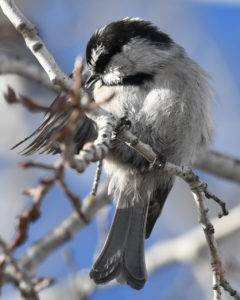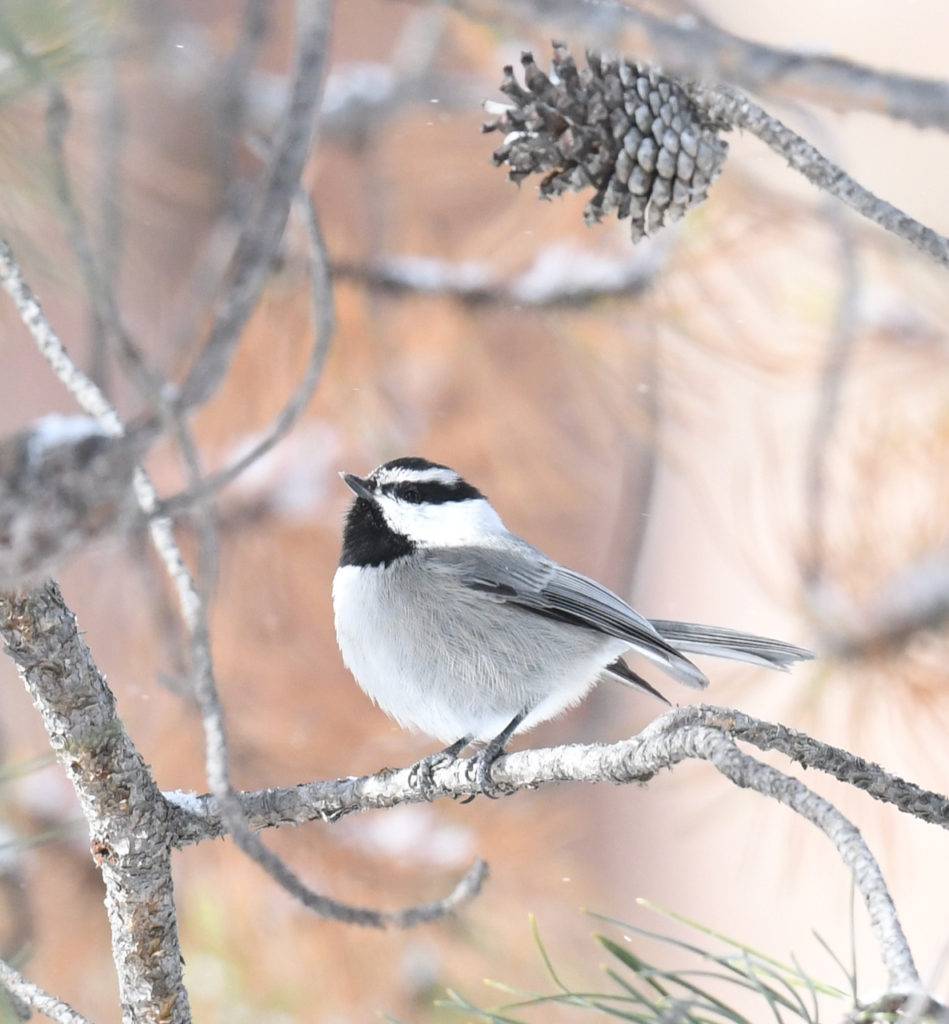by Sevilla Rhoads, SNCO Volunteer

Almost every day at the nature center, you can find one of the cutest of our local little birds: the Mountain Chickadee (Poecile gambeli). It is hard not to smile while watching these little soft, and spirited birds busy themselves around the center. Even on the coldest Sunriver days when Lake Aspen freezes, you usually can find Mountain Chickadees ferrying seed from the feeders to the shelter of the pines. If you find the feeders deserted and the garden either silent or full of Chickadee alarm calls, that usually means a hawk or an owl is hunting close by. Northern Pygmy Owls and hawks, like the Sharp-shinned, are this bird’s main predators.
You may be tempted to brush off a Mountain Chickadee sighting as nothing special. After all, they are one of the most common birds around Sunriver, and they are small with relatively dull coloring. Compared with the large raptors of the area, they don’t tend to hold people’s attention and interest for long. However, Chickadees are one of our more fun birds to watch, especially for children, because they are acrobatic, talkative, and less shy than most other species.
Pause to marvel at how these Chickadees hang like monkeys on the pine cones, leaves, and feeders. Not only do they eat seeds, but they are also hunting insects. Mountain Chickadees are one of our best free pest control services. In one Arizona study, a Mountain Chickadee was found with over 275 tree pest larva in its stomach! These tiny birds help our beautiful conifers stay healthy.
This species likes to hang out on the Western side of the country. They tend to breed and live near evergreen forests, and many live in the mountains. Depending on the weather, some of these birds visit lower elevations to find more find food and warmth in the winter.
Mountain Chickadees can die during a cold night if they do not eat enough calories each day. Unlike many other small birds in this area, such as Pygmy Nuthatches which snuggle up together for warmth, this Chickadee usually braves the winter nights alone in a hole or under a loose piece of bark. The need for fat at the end of the day is the reason you might notice more Chickadees on the feeders in the late afternoons. If you find a dead Chickadee on a chilly morning, it probably could not eat enough the day before to survive. So, if you have feeders, think about checking if there is enough left for the Chickadees in the afternoon. They enjoy both suet and seeds.
Mountain Chickadees can live up to ten years and often stay in the same area most of their lives. Frequently, they form life-long pair bonds, and both parents help raise the young. They usually nest in preexisting holes (it is hard to peck a deep hole in a tree with a little bill unless the wood is soft). They line the cavities with soft materials like fur and even make fur plugs or ‘doors’ to cover the entrance when they are out. You may have seen coyotes hunting rodents around the Sunriver airport. Coyote fur is a favorite for Mountain Chickadee bedding. However, these birds also can pull off fur (and maybe ticks and lice) from live animals like raccoons and dogs. A couple of years ago, a Mountain Chickadee nested near the Nature Center’s Golden Eagle aviary. The Eagle cast pellets every day after it ate its rodent meal. The intelligent Chickadee would fly into the aviary several hours later and pull out the rat fur for its nest lining!
One ‘note’ about this bird we should not overlook, is their astonishing variety of songs and calls. One local birder explained their calls have over a dozen variations. Some calls warn of predators, some are social ranking and territory proclamations, some are for courting, and, we are convinced, some are just for fun! It is amusing to imagine what they are saying if you listen as you watch. If you spend time learning all their local dialects, research suggests you will discover Chickadees even have special calls which identify different predator types. Specific call patterns may alert the flock how an attack is likely to occur so they can mount the best defensive tactics.
By the way, the ‘gambeli’ in this bird’s scientific name honors the naturalist William Gambel who had an interesting, but ultimately tragic life: https://en.wikipedia.org/wiki/William_Gambel
According to Cornell’s All About Birds, while listed as a species of “Least Concern,” from 1966 through 2014, the Mountain Chickadee population declined around 1.5 percent a year which is about a fifty-three percent loss of these birds.
Photos: Sevilla Rhoads

How to identify a Mountain Chickadee
Small (5-6’’) and mostly gray with black triangle shaped bib, white cheek, and white eyebrow through a black cap. Little dark bill and dark eye in the lower black head stripe. Can be buff colored on sides and chest is usually pale as compared to darker gray back. Gray tail usually appears shorter than the wing from shoulder to tip when not flying. It is often hard to see the key distinguishing white line on the head, so look carefully before deciding it could be a Black-capped Chickadee (which are very rare in the Sunriver area.)
More information
